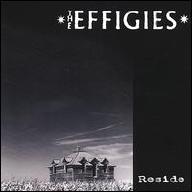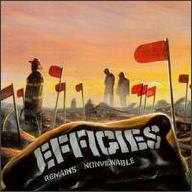The Effigies were formed in 1980, making them one of Chicago's earliest significant punk bands. Their initial lineup featured guitarist John Kezdy, bassist Paul Zamost, drummer Steve Economou, and a vocalist known only as Norman. Norman didn't stick around for long, and Kezdy took over lead vocals and lyric writing; however, he was unable to play guitar and sing at the same time. With the recruitment of guitarist Earl Letiecq, Kezdy gave up the instrument to focus on singing full-time. The Effigies made their live debut in late 1980, and in early 1981 they made their vinyl debut on the locally seminal compilation Busted at Oz, named after the club that served as the epicenter of the early Chicago scene. The band's own debut EP, Haunted Town, followed late in 1981 on the small Autumn label. Unhappy with the label's handling of the record, the Effigies started their own Ruthless label, which would also release early material by Naked Raygun and Big Black, and land a distribution deal with Enigma.
The Effigies' inaugural Ruthless release was the 1982 single Bodybag b/w Security, which was accompanied by extensive national touring. It was followed by another EP, We're da Machine, in 1983, which drew fire from some scenesters for refusing to make explicit political statements, despite the band's clear musical improvement. It was followed in 1984 by the Effigies' first ever full-length album, For Ever Grounded, which bore a stronger post-punk flavor and found the band hitting its full musical stride. However, Letiecq subsequently left, and was replaced by Robert O'Connor. O'Connor made his debut on the second Effigies album, 1985's Fly on a Wire, which found the band now on Enigma affiliate Fever Records. Fly on a Wire was a stripped-down, eclectic affair that threw some fans for a loop, but still won positive reviews.
The Effigies returned to a steadier post-punk, post-hardcore sound on 1986's Ink, which proved to be the band's final album. Its release was delayed until after the tour that had been intended to support the record, and the resulting intraband tensions led to Kezdy's departure and the group's disbandment. They reunited briefly when Metallica offered them an opening slot on their European tour that year, but Kezdy rejected the opportunity over the objections of his bandmates; perhaps it was a fortunate choice, since Metallica bassist Cliff Burton was subsequently killed in a tour-bus accident. In any case, the Effigies disbanded once again.
Kezdy would reunite with Letiecq in 1987, adding a brand-new rhythm section of former Bloodsport members: bassist Chris Bjorklund (also ex-Strike Under) and drummer Joe Haggerty (whose brother John was a member of Naked Raygun). Letiecq departed again in 1988, and when Bjorklund moved to guitar, ex-Bloodsport bassist Tom Woods joined up. Neither of these incarnations made any recordings, due in part to Kezdy's outside commitment to law school, but they did play around Chicago from time to time. In 1989, Roadkill released a retrospective of the group's early, Letiecq-related work called Remains Nonviewable, which was later reissued on CD by Touch Go in 1995. The Effigies disbanded again in 1990, and the original lineup reunited for a one-off show in late 1992; they also reunited again for several shows in late 1995 and early 1996 to commemorate the reissue of Remains Nonviewable. Five songs from one of those gigs were released on a limited-edition EP by VML. ~ Steve Huey, Rovi















